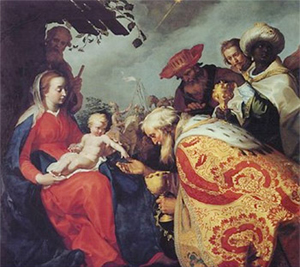Catholic Communications, Sydney Archdiocese,
2 Jan 2013
2 Jan 2013

Visit of the Magi to be baby Jesus
The Solemn Feast of the Epiphany of Our Lord, one of the oldest Christian feats, traditionally occurs on January 6, following the 12 days of Christmas.
Epiphany marks the end of the Christmas season for the Western Church and commemorates three important scriptural events.
These are the visit of the Magi to the stable in Bethlehem following the Nativity of Jesus, the baptism of Christ in the River Jordan and the celebration of Christ's first miracle at the wedding feast of Cana many years later.
Although all three are events that are remembered and celebrated by Christians, it is the three kings, Caspar, Melchior and Balthasar, and their arrival from the East bearing gifts of gold, frankincense and myrrh for the infant Christ that are most closely associated with Epiphany in the Western Church.
In the story, so beloved by children and Catholics everywhere, after seeing the brilliant star in the night sky announcing the birth of the Messiah, the three wise men or Magi, followed the star which took them to Bethlehem. There they visited King Herod of Judea seeking information on where to find the new born king. Not having heard of the arrival of the baby Jesus, and fearing the infant would be a threat to his position as king, Herod instructed the three wise men to seek out the location of the Christ-child and return, to let him know where he was, so that Herod could visit and take him gifts as well.
The Magi found the infant Jesus and paid tribute to the greatest of all Kings as he lay in his crib in a humble stable but they did not return to reveal his whereabouts to Herod. Instead directed by God in a dream, they returned home by another route.
With no information about the whereabouts of the Messiah, Herod proceeded to have his troops slaughter all infants under the age of two to remove the possible threat to his throne. But as we know, the baby Jesus escaped Herod's murderous intentions.
In the Eastern Orthodox Church, January 6 is celebrated as the Nativity of Christ and instead of three kings, the Magi are depicted as 12 in number. But for Western Christians, the Magi are only three in number with each representing one of the world's three main races - African, Asian and European.
Until the Magi's arrival all characters in the Christmas story are Jewish but with the arrival of three Kings, we have the first indication that Jesus and his message are universal and that Christ arrived on earth to preach to the whole world.
Although when most people talk about the 12 days of Christmas the English song of a partridge in a pear tree usually springs to mind. But it is the Feast of Epiphany that the 12th day after Christmas that resonates with Christians and is observed across the world.
The earliest reference to Epiphany (from a Greek verb meaning "to manifest") occurred sometime around 354 AD when the Western Church separated the celebration of the Nativity of Christ as the feast of Christmas and reserved January 6 as the commemoration of the manifestation of Christ, especially to the Magi, as well as his baptism and miracle at the wedding feast of Cana which Ammianus Marcellinus St Epiphanius declared in 361 AD occurred on the same date.
On the Feast of the Epiphany priests wear white vestments. In many countries the Feast is extended from one day to eight days in what is known as the Octave of Epiphany which begins on January 6 and ends on January 13.
In countries, such as Australia, where the Feast of the Epiphany is not regarded as a Holy Day of Obligation, the date of Epiphany varies slightly from year to year and is always celebrated on the first Sunday between that falls between January 2 and January 8.
SHARED FROM ARCHDIOCESE OF SYDNEY